By: debbie lynn elias
From a 1925 Alfa Romeo to Jacki Weaver draped in $2.9 million in diamonds to vintage 1920’s French couture to the ethereal elegance of Cap d’Antibes and Mouans-Sartoux to the ever dashing Colin Firth (*sigh*), Woody Allen steeps us in old world beauty and classic glamour touched with a bit of whimsy and all bathed in the MAGIC IN THE MOONLIGHT. Sparkling and twinkling like the bubbles in a glass of pink champagne or dancing like points of light on a moonbeam, with subtext, humor and romance, Allen creates a period perfect world of enchantment. Calling on his own lifelong love of and fascination with magic, Allen immerses us in an illusory world that beckons believers and non-believers alike, celebrating the era-spawning seances and mediums and a time where illusionists conjured oohs and aahs, much like Woody Allen does with his films.
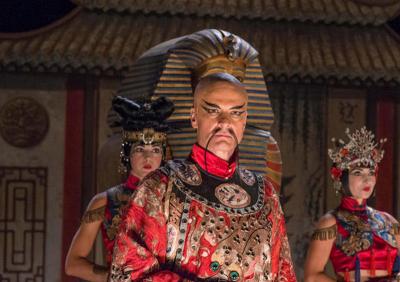
Stanley Crawford is one of the world’s most celebrated magicians. With his true identity known only to fellows of the craft, Stanley is known to his adoring public as Chinese conjuror Wei Ling Soo. Employing many of the same “tricks” and vanishing acts of Harry Houdini, Crawford shares another trait with the master of magic – a fascination with clairvoyance. But while Houdini believes in the afterlife and the ability to make contact with those in the beyond, Stanley does not, and uses his celebrity as a tool to expose and debunk mediums and seances as the fakes he believes them to be.
Having concluded his latest tour through Europe, Stanley is ready for a break when approached by an old friend and fellow magician, Howard Burkan. Seems that Howard and some other friends are looking for Stanley’s help with the wealthy widow Grace Catledge. Grace is desperate to commune with her husband in the spirit world and has summoned a young American clairvoyant named Sophie Baker to her manse in Cote d’Azur to help her do just that. Although Burkan and others can find no incongruities or loose threads in Sophie’s abilities, it is their hope that Stanley can; not only preventing Grace from paying thousands and thousands of dollars to Sophie for her fraudulent chicanery, but also as a means for Burkan to show off Stanley to his other friends and the press as exposing yet another fraud.
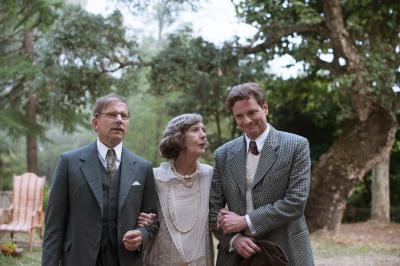
Under yet another guise, that of a traveling businessman and acquaintance of Burkan’s and on the pretext of visiting his aunt who lives nearby, Stanley is invited to visit the Catledge mansion to mix, mingle and be swept into the magic of Sophie’s seances. On meeting Sophie, Stanley is clearly taken aback by her youthful blue-eyed, red-haired, porcelain skinned beauty. Not to be undeterred in his mission, however, he ignores the beauteous nature of the girl, taking a combative, sarcastic, superior tone in voice and demeanor; a tone which Sophie easily matches with wit and wry humor. But someone else also takes an interest in Sophie. Grace’s ukulele playing, one song crooning son, Brice, who vows on first glance to marry Sophie.
The harder Stanley tries to prove Sophie a fake, the more he marvels at her uncanny insights – even finding himself dumfounded when she “contacts” Grace’s deceased husband during a seance. And as hard as Stanley tries with his mission, the harder Brice tries to woo Sophie and the faster she turns a deaf ear. But in one serendipitous drive after visiting Stanley’s Aunt Vanessa, the unthinkable happens. Caught in a rainstorm with a broken down car, Sophie and Stanley take refuge in Stanley’s childhood hideout – the Nice Observatory. And in those brief moments of MAGIC IN THE MOONLIGHT, Stanley must face the inevitable. He’s falling in love with Sophie.
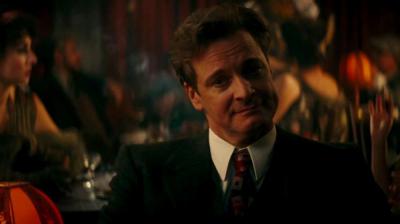
Colin Firth. Dashing, debonair, the epitome of romantic hero. Still, yet and always our beloved “Mr. Darcy”, be he from Jane Austen’s 1813 or Helen Fielding’s 2001 London or here as Stanley Crawford, Colin Firth puts the masculinity and romance in the MAGIC IN THE MOONLIGHT. With a delightful disdain and joyless unhappy chill masking the true romantic beneath, Firth is the master magician as he slowly lets Stanley’s facade crack and then break. Yes, there are moments you will hear a collective *sigh* from the entire female audience as Firth weaves his spell over not only the film and Emma Stone’s Sophie, but the audience as well. Standout are not only multiple monologues Allen has Firth performing but, in essence, several soliloquies. It is rare that we see Firth’s stage talents on display as we do here. He commands the words, the emotion and the screen with each, never faltering and never failing. Particularly enchanting are scenes between Firth and Eileen Atkins as Stanley’s Aunt Vanessa. Many will recall Firth and Atkins as mother and son in “What A Girl Wants”. To see that chemistry revisited here as beloved aunt and doting nephew just adds its own loving magical touchstone to the film.
Emma Stone is her usual exuberant, energetic self. She and Firth dazzle with Allen’s dialogue, capturing the perfect wry tone and tit-for-tat sparring cadence a la Cary Grant and Roz Russell. Interesting is the physicality that Stone brings to Sophie; an almost Elmer Gantry holy roller feel with over-exaggerated arm movements when Sophie “has a vision” but then contrasting that with a temperament that vacillates from ingenue to women’s libber. It’s an interesting juxtapositioned dynamic that while vibrant, doesn’t find real footing.
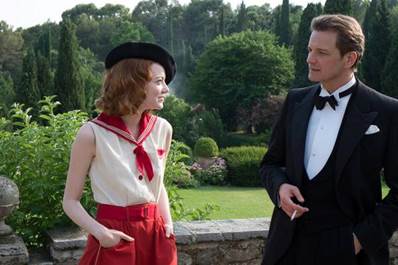
As Howard Burkan, Simon McBurney is a man with a secret; something that McBurney is very skillful at never revealing yet, thanks to expressive eyes, gives us a subtle trail of breadcrumbs to follow and ponder. McBurney is one of the unspoken shining stars among the supporting players.
Hamish Linklater provides some very entertaining comic relief – from Brice’s ukulele playing (for which Hamish hired a teacher to teach him how to play) to the foppish fawning and puppy dog eyes of adoration for Stone’s Sophie. Equally enjoyable is the mother-son dynamic between Linklater and Jacki Weaver who, as comes as no surprise, is chameleonic in her transformation into Grace Catledge. Weaver adds some more levity during seance sequences as she speaks “into the beyond”. Whimsical delight.
Wasted talent is Marcia Gay Harden as Sophie’s mother Mrs. Baker. Prune-faced, calculating and manipulative, her scenes are brief and appear to only serve as one tine to the fork feeding us McBurney’s delicious breadcrumbs.
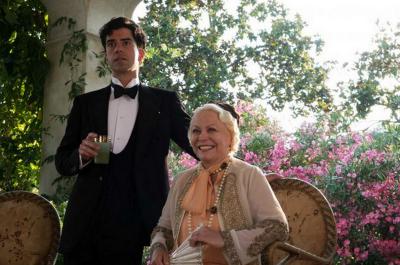
As Allen so adroitly does, he succinctly captures moments in time, romanticizes them with heart and humor, steeping us in time and place but with a timelessness of subtextual thematics, and all without uber-budget tentpole trappings. He relies on quick wit, double entendre, period and class distinctive verbiage and sentence structure of days gone by to inform the characters and the audience. Although somewhat formulaic within the rom-com construct, Allen uses the matter-of-factness of the formula to fuel metaphoric undercurrent discussion of parents and children, wealth and poverty, fact versus fiction, women’s rights, religion versus the supernatural, tricks and tropes and of course, love, with each effervescing like points of light on a moonbeam. Carefully chosen locations and attention to period costume and subtle accoutrement in fashion and production design speak louder and inform more than the most over-stuffed and saturated framing we so often see from other filmmakers. The result is effective, immersive and beautiful and with MAGIC IN THE MOONLIGHT, hints of George Bernard Shaw and Preston Sturges, and days gone by of the grand glamour of the Barrymores and “The Grand Hotel”. Allen succeeds in making us feel like we are in the 1920’s with every moment holding the possibility for magic.
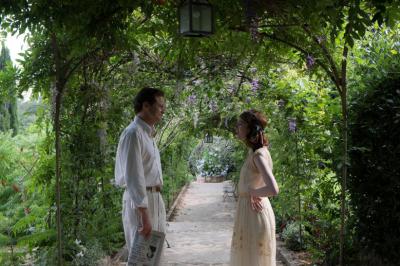
Key to many of Allen’s films, and definitely here, is his work with one of his returning cinematographers, in this case Darius Khondji . Celebrating the longitudinal and seasonal lighting of Cote d’Azur and by lensing on 35mm, Khondji creates a sumptuous yet light sparkling visual palette. Romanticizing the European art deco of the period, Khondji heightened the experience even further using vintage Cinemascope lenses, softening the imagery. Notable is Allen and Khondji’s decision along with color supervisor Pascal Dangin in post-production to render of the frames so as to give the film a 1920’s autochrome color. Adding further to MAGIC IN THE MOONLIGHT, in particular, is Allen’s method of creating a frame and having the camera placed. The camera rarely travels with a shot. The shot is framed and the actors move within the frame. There are few if any cut-aways, thus creating a fuller portrait of the characters and fluidity of emotion within a scene.
Costumer Sonai Grande outdoes herself here with vintage originals and couture design of the era which, when necessary, were made for the film with fabrics and trims from the 1920’s. Although Linklater wasn’t too fond of the period tuxedos (“They were very uncomfortable”), Weaver was thrilled with the elegance of not only her costumes, but the $2.9 million in diamonds she wears in the party scene. As comes as no surprise, clothing color is key to the characters and their respective philosophies; for example, Firth’s Stanley is not only initially in rigidly constructed three piece suits, but in dark colors. As the film progresses and as Stanley’s mind opens to possibilities of life and the life after, the color of his clothing lightens as does the fabric as we soon see him in casual cream colored linen. Jacki Weaver’s Grace, a believer from the start, is always in light toned pastels, whites, silvers, silks and satins while reds and golds are prevalent in the design of Stone’s Sophie.
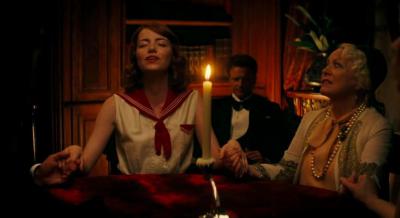
Production design by Anne Seibel is breathtaking and never moreso than with the design of the party scene which is a color-rich sparkling splendor reminiscent of Joss Whedon’s twinkling black and white backyard gala in “Much Ado About Nothing” or Max Reinhardt’s 1935 “A Midsummer Night’s Dream”. Capitalizing on lush locales like Villa Eilenroc in Cap d’Antibes, Villa la Renardiere in Mouans-Sartoux and the Chateau du Rouet vineyard in Le Muy, perhaps the most magical and historically awe-inspiring is the Nice Observatory boasting a dome designed by Gustave Eiffel (yes, that Eiffel). MAGIC IN THE MOONLIGHT is rich in visual historical opulence.
Classic romanticism told with the whimsical humor that is Woody Allen, MAGIC IN THE MOONLIGHT is just that – magic.
Written and Directed by Woody Allen
Cast: Colin Firth, Emma Stone, Eileen Atkins, Jacki Weaver, Simon McBurney, Marcia Gay Harden, Hamish Linklater













